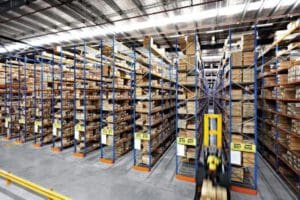
Advanced Handling & Storage Ltd
The Pallet Racking People

Supply chain 4.0 – the integration of Internet of Things (IoT), advanced robotics, analytics and Big Data – will bring many benefits. At the same time, it requires companies to become more efficient, flexible, accurate and capable of handling much greater level of detailed information.
1 – Overcoming Intense Price Competition
E-commerce has removed barriers to entry and intensified competition. This has increased customer service expectations and the pressure to offer the lowest prices and delivery costs. In the past, companies might have focused on turnover believing that high sales will eventually translate into profits, but when price sensitivity is extremely high, margin is the key metric.
2 – Expectation of Traceability
Linked to improved service levels is an expectation for improved data and traceability. It is not good enough to do a great job, customers now expect an audit trail too. This means capturing additional information to verify provenance of goods and reassurance that they will be arriving on time and in full. The requirement for an audit trail goes beyond typical lot traceability. For example, within the food service sector, fresh produce has been identified and tagged for decades but now, suppliers are also expected to provide information on the origins of produce and all the raw materials or feeds used during production.

3 – Explosions of SKUs
Customers want to be treated as individuals and expect the choice of products available to reflect this. The range of products that manufacturers are required to offer is growing all the time, with custom options inflating SKU portfolios. Added to this, the frequency of change has also increased. This creates an immediate practical problem, because although new lines can be added to the production line, the warehouse may not have been set up to handle such a large SKU portfolio, which has implications for stock management and order turnaround times. One way to overcome this is with the introduction of dynamic slotting to improve space utilisation efficiency.
4 – Managing Multiple Order Profiles
Order profiles have changed dramatically as a result of ecommerce. For manufacturers, it may create an opportunity to sell direct to the end consumer and improve margins, but the warehouse may not be optimised for handling high volume single item orders shipping to retailers more frequently, which can imbalance the potential to increase margins with greater warehouse costs. Manufacturers need to identify ways to handle multiple order profiles, for example with the introduction of automated batch pick and sort processes.
5 – Dashboards to inform Decision Making
Vast volumes of data generated have created a need for dashboards providing an immediate snapshot of warehouse management operations. Most companies have more data than they require to inform decision making, and require a way to highlight what’s significant
6 – Forecasting Accuracy Requirements
Lead times in supply chains are getting longer all the time, which in turn has made forecasting accuracy more critical. By having an accurate forecast, companies can become more agile when sourcing raw materials for the lowest prices, they can benefit from the costs associated with longer shipping lead times whilst still meeting demand, and ultimately keep inventory levels as low as possible.
7 – Opportunity to Implement ‘Predictive Shipping’
Although Amazon may be trademarking the concept of predictive shipping, the idea behind the approach has been in operation for some time. Lot of businesses are using techniques similar to predictive shipping to plan production and shipping cycles and meet demand.

8 – Quality Checks Built in to the Supply Chain
To ensure consistent quality inbound process and product quality checks are being conducted right across the supply chain. Manufacturers and brand owners are moving the onus for quality to their suppliers and putting systems in place to give them full visibility that inventory control and quality checks are being completed in a standardised way. This is happening in real time so that by the time goods leave the warehouse for the end customer, a full audit trail is available.
9 – Requirement for Accuracy
Accuracy is the single most important aspect of supply chain 4.0 to get right because the vast majority of warehouses are measured by their ability to get OTIF (on time in full) or OIFOT (orders in full on time), with no margins for error.
10 – Arrival of Automation
While full automation may be an option for larger manufacturers, the majority of companies are taking a partial approach. This ensures that they can maintain greater levels of flexibility and reduces the capital expenditure required. Many of the efficiency and accuracy benefits can still be seen when conveyors and cardex systems integrated with a WMS are added to control stock on a pick face.
….. phew! So that’s that!
Get in Touch with Advanced Handling & Storage
If you want to maximise your warehouse space through the use of second hand or new pallet racking, please don’t hesitate to get in touch with us on 0800 345 7088 or send an email to [email protected]
Make sure you follow #TeamAdvanced on Social media for all our latest news and offers!
Like us on Facebook
Follow us on Twitter
Connect with us on LinkedIn
Subscribe to Our YouTube channel
Follow us on GooglePlus
Read our other blogs on Medium
Follow us on Instagram